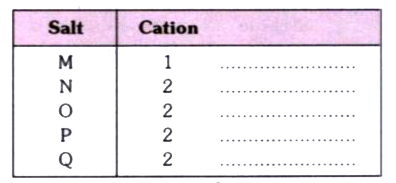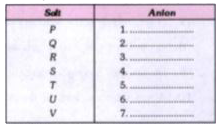When tetramethyl ammonium hydroxide is heated strongly, it yields methanol and trimethylamine . How is methanol formed : To what general calss of reaction does this belong ?
This is by E2 eleimination
⎡⎢
⎢
⎢⎣CH3−CH3∣.⊕N∣CH3−CH3⎤⎥
⎥
⎥⎦ΘOHΔ−−→CH3OH+Me−Me∣N−Me
If one or more groups other than CH3 are present , then alkene will be formed (less substiuted , Hofmann rule ) instead of CH3OH.
Topper's Solved these Questions
- ORGANIC COMPOUNDS WITH FUNCTIONAL GROUPBOOK - CENGAGE CHEMISTRYCHAPTER - ORGANIC COMPOUNDS WITH FUNCTIONAL GROUPEXERCISE - Exercises Concept Application
13 Videos
- ORGANIC COMPOUNDS WITH FUNCTIONAL GROUPBOOK - CENGAGE CHEMISTRYCHAPTER - ORGANIC COMPOUNDS WITH FUNCTIONAL GROUPEXERCISE - Exercises Linked Comprehension
25 Videos
- ORGANIC COMPOUNDS WITH FUNCTIONAL GROUPBOOK - CENGAGE CHEMISTRYCHAPTER - ORGANIC COMPOUNDS WITH FUNCTIONAL GROUPEXERCISE - Solved Examples
12 Videos
- NUCLEAR CHEMISTRYBOOK - CENGAGE CHEMISTRYCHAPTER - NUCLEAR CHEMISTRYEXERCISE - Archives Subjective
13 Videos
- P-BLOCK GROUP 15 ELEMENTS - THE NITROGEN FAMILYBOOK - CENGAGE CHEMISTRYCHAPTER - P-BLOCK GROUP 15 ELEMENTS - THE NITROGEN FAMILYEXERCISE - Exercises Archives (Subjective)
28 Videos
Similar Questions
Knowledge Check
Trimethyl ethyl (A) ammonium iodide is allowed to react with silver hydroxide and the product formed is heated strongly at about 400 K. The final products are
ACH2=CH2 and (CH3)2CHCNBCH3CH2CN and C2H5NH2CCH2=CH2 and (CH3)3ND(CH3)2C=CH2 and NH3.Identify the amine formed when ethyltrimethy! ammonium iodide is treated with silver hydroxide and further heated strongly
AC2H5N(CH3)2BC2H5NH2C(CH3)3NDCH3NH2
a. Write the reaction of EtOH with (i) KNH2 (ii) aq. KOH (iii) Potassium ethynide.
b. Complete the following reaction:

c. Why is methanol more toxic than ethanol ? How is a methanol Poisoned patient treated ?
d. How does the ingestion of ethanol in low and high concentration affects the central nervous system ?
View SolutionWhen glucose is heated with methanol in the presence of dry HCl gas, it forms one methyl glycoside.
View SolutionB2H6 on reaction with methanol does not form
View Solution(a). What happens when zinc granules are heated with sodium hydroxide solution? Write equation of the reaction which takes place.
(b). What happens when bases react with non-metal oxides? Explain with the help of an example. What does this reaction tell us about the natrue of non-metal oxides?
View SolutionSalts M, N, O, P and Q undergo reactiom (i) to (v) respectively.
Identify the cation present in these salts on the basis of these reaction. Tabulate your answer in the format given below.
1. When sodium hydroxide solution is added to the salt M, and heated strongly a colourless gas with a pungent smell is evolved which turm red litmus paper blue and gives dense white fumes with a moist glass rod with hydrochloric acid.
2. Addition of dilute hydrochloric acid to a solution of N gives a thick white precipitate which is soluble in hot water.
3. When ammonium hydroxide solution is added to the solution of 0 a light blue precipitate is obtained which is soluble in excess of ammonium hydroxide to form an inteme deep blue solution.
4. When ammonium hydroxide solution is added to the solution of P reddish brown (mustard colour) precipitate is obtained which ,is insoluble even in the excess of ammonium hydroxide solution.
5. When sodium hydroxide solution is added to the solution of Q a which coloured gelatinous precipitate is obtained which is soluble in excess of sodium hydroxide to form a clear solution

View SolutionSalts P, Q,R,S,T,U and V undergo reactions (i) to (vii) respectively. Identify the cation present in these salts on the basis of these reactions. Tabulate your answer in the formate given below.
(i) When the salt Pis heated with sodium hydroxide solution a vigorous reaction takes place and a colourless gas is evolved with a pungent and suffocating smell that brings tears in our eyes. The evolved gas gives dense white fumes with a moist glass rod depped with hydrochloric acid.
(ii) Addition of sodium hydroxide solution to a solution of salt Q gives a thick white precipitae which is soluble in excess of sodium hydroxide solution to form a clear solution.
(iii) Addition of ammonium hydroxide solution to a solution of salt R gives a dark blue precipitate which is soluble is excess of ammonium hydroxide solution to form an intense deep blue solution.
(iv) Addition of ammonium hydroxide solution to a solution of 5 gives a dirty green [bottle green] precipitate which is insoluble even in the excess of ammonium hydroxide solution.
(v) Addition of ammonium hydroxide solution to a solution of T gives a reddish brown (rust precipitate] precipitate which is insoluble even in the excess of ammonium hydroxide solution.
(vi) Addition of ammonium hydroxide solution to a solution of V gives a geletaneous white precipitate which is soluble in excess of ammonium hydroxide solution to form a clear solution.
(vii) Addition of ammonium hydroxide solution to a solution of V gives no precipitate but it gives a chalky white precipitate with sodium hydroxide solution which is insoluble even in the excess of sodium hydroxide solution.

View Solution
